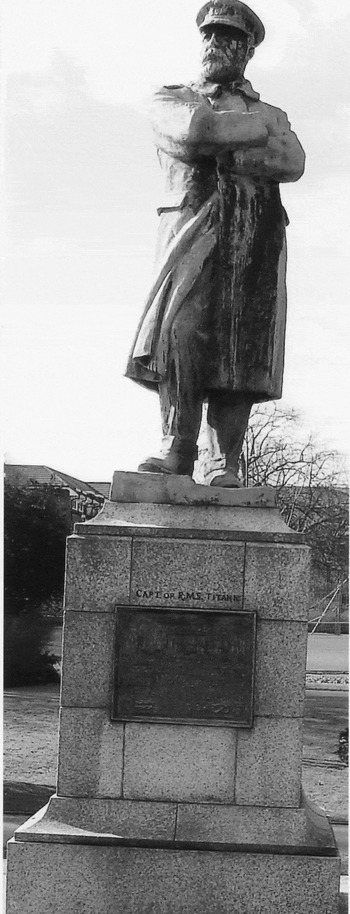Visiting the city of Lichfield, Staffordshire, recently, the author was surprised to discover a handsome statue of Captain Edward John Smith, master of Titanic in 1912 on her first and only voyage (Fig. 1). That the sculptress was none other than Captain Robert Falcon Scott's widow, Kathleen, added even greater interest. The statue stands in Beacon Park, facing in the distance and nearer to the road, a statue of King Edward VII. The inscription reads:
COMMANDER EDWARD JOHN SMITH R.D., R.N.R., BORN JANUARY 27, 1850. DIED APRIL 15, 1912. BEQUEATHING TO HIS COUNTRYMEN THE MEMORY AND EXAMPLE OF A GREAT HEART, A BRAVE LIFE, AND A HEROIC DEATH. BE BRITISH!
The ‘R.D.’ refers to the Royal Naval Reserve Decoration that Smith held and ‘Be British!’ are believed to have been his last words.

Fig. 1. Statue of Captain Edward John Smith.
The words, ‘CAPT. R.M.S. TITANIC’ appear above this (Fig. 2). ‘K. Scott’ can be made out below Smith's feet (Fig. 3). Smith was a native of the Potteries, born in relatively humble circumstances in Hanley, Stoke-on-Trent, who rose to eminence in the merchant shipping world (Cooper Reference Cooper1992).

Fig. 2. Inscription on statue.

Fig. 3. Mark of sculptress on the base of the statue.
The bronze statue (over 4.27 m (14 ft) in height including the granite plinth) was unveiled on 29 July 1914 by Smith's daughter, Miss Helen Melville Smith, in the presence of his widow and a distinguished company. These included Lady Scott, Admiral of the Fleet Lord Charles Beresford, and Millicent, Duchess of Sutherland. In the absence of the chairman of the memorial committee, William Boyd Carpenter, former Bishop of Ripon, the presentation of the statue to the city was performed by William Wilcox Perrin, Bishop of Willesden. Lichfield had been designated as its site because it was in Captain Smith's diocese, but also because a plaque had already been placed in Hanley town hall and because travellers from London or Liverpool would find Lichfield easy of access by train. Letters to the Lichfield Mercury show that a number of citizens were, in fact, unhappy that their city had been chosen by the committee. Tributes included a message from Queen Alexandra and from others who had sailed with Smith as passengers, not a few of whom were American subscribers to the memorial. One of these was the writer Ernest Seton Thompson of Connecticut. The Lichfield Mercury of 31 July 1914 carried a full account of the proceedings that took place only days before the outbreak of World War I.
In his speech which praised Captain Smith and which emphasised the great dependence of the country on the mercantile marine, especially in time of war, Beresford observed that the statue had been executed by the wife of one of the most distinguished naval officers ‘whose last letters were perhaps the most pathetic letters of our time—those he wrote to his countrymen. That officer also died in the execution of his duty.’ In her speech, the duchess told the audience that they should ‘not grieve too much that Captain Smith lay in the mysterious sea that had swallowed silently. . . . . many of their darling dead’. She reminded them ‘how the Psalmist sang that those who dwelt in the uttermost parts of the sea should take the wings of the morning. Surely on the wings of the morning they would see the face of God’ (Psalm 139). Her late husband had greatly respected Captain Smith, she said. One wonders whether in fact she were the moving spirit behind the memorial, since the Sutherlands were extensive landowners in Staffordshire.
The statue is listed with other commissions in Kathleen Scott's published diary (Kennet Reference Kennet1949), and there is mention of it in Louisa Young's 1996 biography A great task of happiness (Young 1996). Kathleen's diary for that day records that she traveled back to London with the bishop, whom she found ‘rather a good old boy’. She also wrote, ‘My statue of Captain Smith of s.s Titanic was unveiled at Lichfield. Lord Charles Beresford and the Duchess of Sutherland spoke. She looked adorable and made an excellent speech’ (Kennet Reference Kennet1949: 127).
Acknowledgements
The author is grateful to the Lichfield Library, The Friary, Lichfield, and to Mrs B. Rainbow and Mrs M.H.N. Swinburne of Newcastle-under-Lyme, who travelled to Lichfield to photograph the statue. The Revd. Simon Rowlands kindly referred the author to Psalm 139.





